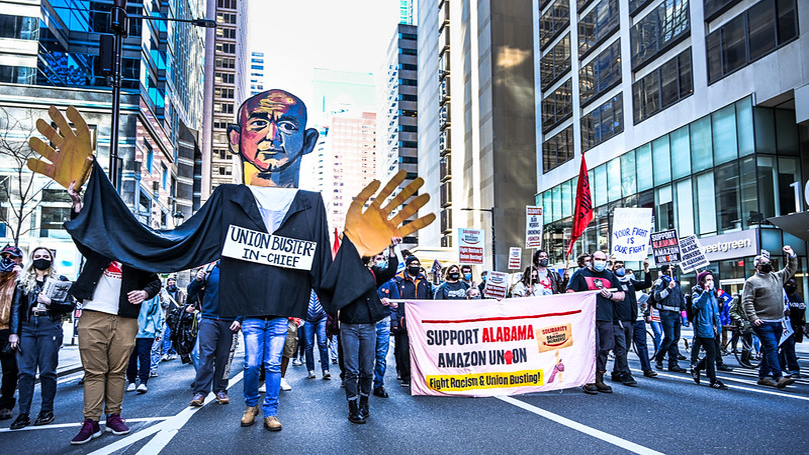
The Amazon union recognition campaign has exposed both the damage of the past 70 years of repression and the compelling need to restore the rights of labor in the United States. The importance of understanding the challenges, the opportunities, and principles of labor organizing in the 21st century cannot be understated at this critical juncture.
I would begin with a tribute to the leadership of the Retail, Wholesale and Department Store Union (RWDSU), its staff, and the frontline committee for the union in the Amazon Bessemer warehouse for a truly heroic campaign. Nearly 800 workers courageously took on the richest man and one of the richest corporations in the world, and stuck it out through the terror of a modern union-busting campaign. Whether they are aware of it or not, many are on the road to becoming Bolsheviks. They have been through the fire and are acquiring the resilience and dedication to each other that have always been the preparation of freedom fighters of the truest spirit.
I was hoping the RWDSU would speak out first. They deserve the first microphone. However, their pending unfair labor practices charges against Amazon may prohibit them from issuing public statements that could jeopardize their legal position.
I have read a range of analyses of the Amazon struggle over the past weeks. I recommend Mark Gruenberg’s in the People’s World and Frank Emspak’s article in Portside, of those I have seen. Several articles have also appeared headlining criticisms of the RWDSU’s organizing tactics. The union lost the NLRB election better than two to one, so a critical review is unavoidable.
The “blitz” strategy
The source of much criticism arises from the weaknesses of so-called hotspot or blitz campaign styles adopted by some unions. Actually, probably most unions have tried blitz tactics at one time or another.
The concept is simple. You get reports of protests, scandals, grievances, discrimination, occupational injuries, or illnesses. Interviews with initial contacts lead you to believe a majority of the workers in the facility would support unionization and collective bargaining. You mount a very public card-signing campaign accompanied by a very robust public relations pitch designed by experts in PR messaging.
Most times, the blitz style is not expected to succeed. But occasionally it does. And since anti-labor tactics have become steadily more pronounced, that “occasion” can come more frequently, and at less cost, than more strategic, long-term concentration approaches. From the standpoint of an organizing director of a 21st-century union — it is a relatively efficient way of testing genuine “hotspot” interest in the facility. Further, do not underestimate the stresses on union organizational budgets in this period — they are intense. The alternative approaches may be simply too costly to seriously develop with paid staff. Most union resources are naturally drawn to defenses of their existing membership against attacks.
However, the efficiency argument cannot dispel the weaknesses inherent in the blitz tactic.
It takes a lot of work — expensive work, especially if hiring outside staff — and intensive relationship building to fully develop inside leadership beyond the “I will sign a card, and wear a button” standard.
But if you skip this work, serious miscalculations can be made:
undercounting the real number of workers in the bargaining unit;
incorrectly understanding the workplace processes or the chain of command;
failure to understand the employer business model;
failure to understand the role of the particular facility in the corporate structure;
not sufficiently knowing the relationships or family connections in the workplace or their history, and the nationality, racial, and gender dimensions of the workforce;
not knowing the real social leadership in the workplace: the people most trusted, most skilled, most helpful, who work the hardest.
Further, an important attribute of effective in-plant leadership is a solid reputation among the workers and a high level of organizational (“political”) skill needed to interact effectively with management. Blitz campaigns often fail to develop those folks, or they miss those altogether, even if they win the election. That can lead to trouble when the rubber hits the road between rhetoric and results — getting a contract.
Rank-and-file organizing
An alternative strategy — let’s call it the rank-and-file approach — undertakes careful development of workplace committees. Early TUEL (Trade Union Educational League) and TUUL (Trade Union Unity League) committees were indispensable to the victories of the CIO. These committees were led by communists, socialists, and other labor radicals. The work was not performed by paid organizers. The networks were built almost entirely on personal and social relationships. In this strategy, the “union” is already organized, functioning, and trained to resist the counterattacks in an election campaign, before the demand for recognition is made.
The leaders of the East Pittsburgh Westinghouse UE recognition drive, in 1937, had 19,000 workers paying dues through an already organized steward system. An amazing feat, considering this was accomplished before the election.
The rank-and-file approach, if pursued persistently and faithfully, can make even a blitz campaign a success. But time, the economic environment, and other external factors can stall progress with the rank-and-file approach too. On the battlefield, the base can be eroded, no matter how strong you hope it is, because workers are dependent on the jobs wholly owned by the boss. Another reason to pay close attention to longer term organizing forms like the Southern Workers Assembly, other rank-and-file formations, or the Communist Party.
Beyond the “alternative” strategies there is the struggle for social unionism — bargaining beyond the workplace and into the public square. Another strategy is representing union interests while sitting on corporate boards. European social democracies, for example, encourage worker/union participation on boards of directors. In big corporations, there are few other paths to obtain the information needed to effectively bargain. Further, a direct union role in the transfer of workers laid off from one sector to another requires stronger legal standing and recognition than is possible under current law.
Political and social alliances are key to gaining recognition in a hostile environment. The public interest in recognizing collective bargaining rights must be defined, whether on moral, civil rights, safety, or economic grounds. Allies must be identified, especially to defend against the use of cops, lawsuits, and force by employers or their allies. The Pro Act will not negate the need for such political considerations, but it can act like a giant amplifier, endorsed by the President, turning a key success into a powerful movement and an explosion of organizing — like what happened in the wake of the famous Flint sit-down strike.
All tactics, however, will be improved by communists, socialists, and other labor radicals who are inside the workplaces.
Just because left ideology gains significant interest among the workers, and can play a very positive role, it is important to not get ahead of the most important strategic demand, which is recognition — meaning legitimacy, standing, and respect. And never forget the economics. Whatever the politics, every local joins the higher wages party implicitly.
Lastly, making the rank-and-file approach work depends on a strong collective. A worker in a key workplace, for example, who is a member of a club, needs strong and disciplined support and help to manage the many challenges and connections that developing a serious campaign entails.
Find something for everyone to do. Leave no one behind. Organizing a union is hard, but fun too. The day you confront the boss with the demand for recognition with the support of a solid majority of employees will be one of the biggest thrills of your life!
The opinions of the author do not necessarily reflect the positions of the CPUSA.
Image: Joe Piette (CC BY-NC-SA 2.0).


 Join Now
Join Now